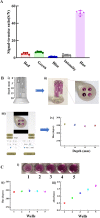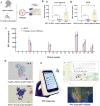Real-time Colorimetric Quantitative Molecular Detection of Infectious Diseases on Smartphone-based Diagnostic Platform
- PMID: 32488061
- PMCID: PMC7265458
- DOI: 10.1038/s41598-020-65899-w
Real-time Colorimetric Quantitative Molecular Detection of Infectious Diseases on Smartphone-based Diagnostic Platform
Abstract
Rapid diagnostics of infectious diseases and accurate identification of their causative pathogens play a crucial role in disease prevention, monitoring, and treatment. Conventional molecular detection of infectious pathogens requires expensive equipment and well-trained personnel, thus limiting its use in centralized clinical laboratories. To address this challenge, a portable smartphone-based quantitative molecular detection platform, termed "smart connected pathogen tracer" (SCPT), has been developed for pathogen monitoring and disease surveillance. The platform takes advantage of synergistically enhanced colorimetric loop-mediated isothermal amplification (LAMP) assay and smartphone-based color analysis, enabling simple, rapid and reliable nucleic acid quantification without need for expensive fluorescence detection equipment. The SCPT platform has been successfully applied to quantitatively detect: i) HPV DNA in saliva and clinical vaginal swab samples, and ii) HIV RNA in plasma samples with comparable sensitivity to state-of-art machine. It has also been demonstrated for disease spatiotemporal mapping and pathogen tracking by wireless connection and web-based surveillance. Such simple, cost-affordable, portable molecular detection platform has great potential for on-site early disease detection, remote healthcare monitoring, and epidemic surveillance.
Conflict of interest statement
The authors declare no competing interests.
Figures




Similar articles
-
Synergistically enhanced colorimetric molecular detection using smart cup: a case for instrument-free HPV-associated cancer screening.Theranostics. 2019 Apr 13;9(9):2637-2645. doi: 10.7150/thno.32224. eCollection 2019. Theranostics. 2019. PMID: 31131058 Free PMC article.
-
3D-printed Point-of-Care Platform for Genetic Testing of Infectious Diseases Directly in Human Samples Using Acoustic Sensors and a Smartphone.ACS Sens. 2019 May 24;4(5):1329-1336. doi: 10.1021/acssensors.9b00264. Epub 2019 Apr 25. ACS Sens. 2019. PMID: 30964650
-
μLAMP-LFA: A nucleic acid analysis platform for the field diagnosis of pathogens in aquatic animals.Anal Chim Acta. 2025 Jul 22;1360:344144. doi: 10.1016/j.aca.2025.344144. Epub 2025 May 2. Anal Chim Acta. 2025. PMID: 40409910
-
Smartphone technology facilitates point-of-care nucleic acid diagnosis: a beginner's guide.Crit Rev Clin Lab Sci. 2021 Mar;58(2):77-100. doi: 10.1080/10408363.2020.1781779. Epub 2020 Jul 1. Crit Rev Clin Lab Sci. 2021. PMID: 32609551 Review.
-
Smartphones as mobile microbiological laboratories.Clin Microbiol Infect. 2020 Apr;26(4):421-424. doi: 10.1016/j.cmi.2019.09.026. Epub 2019 Oct 11. Clin Microbiol Infect. 2020. PMID: 31610301 Review.
Cited by
-
LAMP-Based Point-of-Care Biosensors for Rapid Pathogen Detection.Biosensors (Basel). 2022 Nov 23;12(12):1068. doi: 10.3390/bios12121068. Biosensors (Basel). 2022. PMID: 36551035 Free PMC article. Review.
-
Maximising Affordability of Real-Time Colorimetric LAMP Assays.Micromachines (Basel). 2023 Nov 15;14(11):2101. doi: 10.3390/mi14112101. Micromachines (Basel). 2023. PMID: 38004958 Free PMC article.
-
Development of Reverse Transcription Loop-Mediated Isothermal Amplification Assay for Rapid and On-Site Detection of Avian Influenza Virus.Front Cell Infect Microbiol. 2021 Apr 19;11:652048. doi: 10.3389/fcimb.2021.652048. eCollection 2021. Front Cell Infect Microbiol. 2021. PMID: 33954120 Free PMC article.
-
Overview of Optical Biosensors for Early Cancer Detection: Fundamentals, Applications and Future Perspectives.Biology (Basel). 2023 Feb 1;12(2):232. doi: 10.3390/biology12020232. Biology (Basel). 2023. PMID: 36829508 Free PMC article. Review.
-
Point of care colourimetric and lateral flow LAMP assay for the detection of Haemonchus contortus in ruminant faecal samples.Parasite. 2021;28:82. doi: 10.1051/parasite/2021078. Epub 2021 Dec 15. Parasite. 2021. PMID: 34907897 Free PMC article.
References
Publication types
MeSH terms
Substances
Supplementary concepts
Grants and funding
LinkOut - more resources
Full Text Sources

